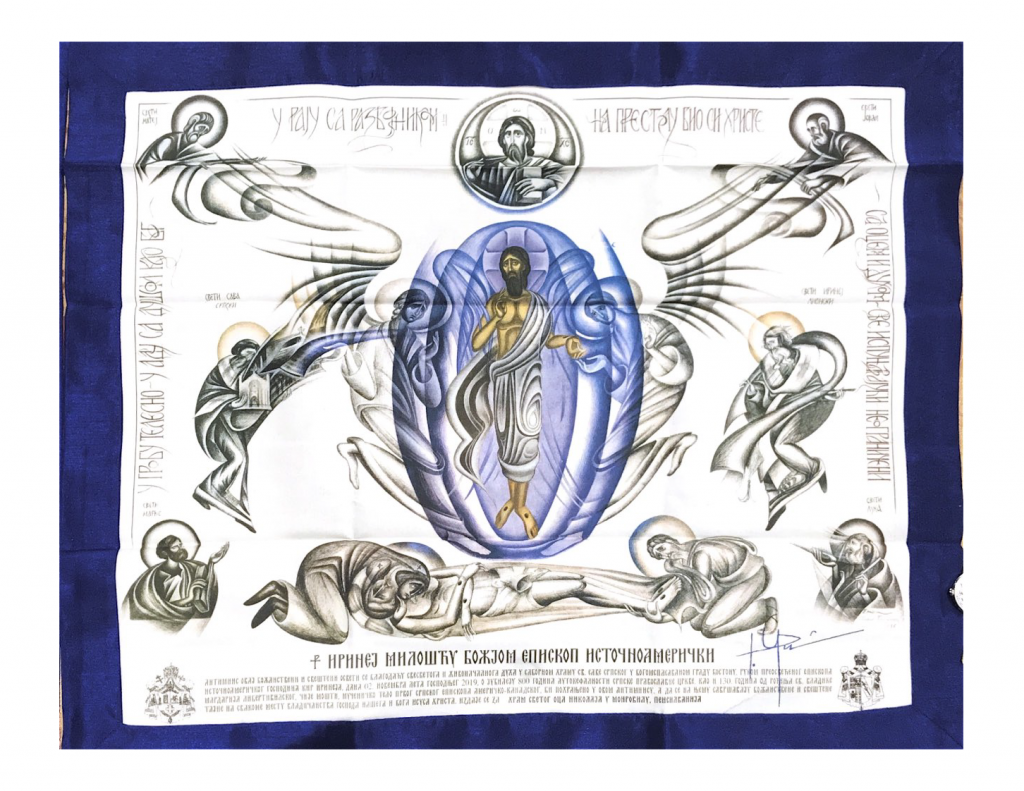Whenever we want to make a nice dinner and invite our friends and family to join us, we would always add a nice table cloth to complement the delicious food we make. This applies to meals that we prepare at our homes, but this also applies to the meal which is prepared in the Church. What is this meal? It is the eucharist, served in the divine liturgy.
The divine liturgy, as every other service in the Church, was and still is developing. Many things changed in the way the liturgy was served in the first centuries, but there is one thing that has stayed much the same, the antimension. The antimension is a liturgical object which is located at the center of the divine table. You may notice its bright blue hue contrasting our altar table here at St. Nicholas during the liturgy.

We all know that the first eucharistic celebration took place when Jesus ate his last supper with his disciples. In a way, that was the first dinner which started all other dinners, which we call liturgies. The early Christians did not have big Churches in which to gather, but instead they gathered in homes. Each home had a head of the liturgical celebration appointed by the apostles. Later, during the centuries of the persecution of Christians, they celebrated the eucharist on the tombs of those who had died for Christ because of the sanctity of the place which was radiating from the martyrs’ bodies.
When Christians were finally free to build churches, they retained certain elements of these earlier eucharistic celebrations. They kept the relics and they kept the antimension and turned it into one object. In what way? Relics were sewn into the eucharistic dining table cloth that is, the antimension. We continue this tradition, serving the liturgy on them until this very day.
The word antimension means literally ‘instead of the table’. The table which we are referring to here is the table of the head of the eucharistic dinner. As the bishop is the head of our diocese, so too he is the head of the dinner. Whenever we serve the eucharist, we serve it on the antimension as a reminder that the “table cloth” we are having at the center of the altar table has only one host, who is the bishop. It is through the blessing of the bishop and through the bestowing of the table cloth which is called antimension that he grants us permission to serve the eucharist. Without the antimension, a priest cannot serve the liturgy.
We said at the beginning that a nice table cloth goes with a nice dinner. The best dinner, the life-giving dinner which is the body and blood of Christ, deserves the best table cloth. Besides elaborate stylistic details, our antimension also contains the relics of the saints as does every antimension. The relics we have are those of the martyrs of Prebilovci, St. Mardarije and a piece of ribbon blessed at the belt of the Theotokos at the Holy Mountain in Greece.

6 Responses
Thank you, Fr. Stefan!
Another informative and wonderful lesson for us all, young and OLD! we know that you are busy, but please keep the information coming. Looking forward to Bible Study, Lord willing, one day, soon.
Father Stefan, this is wonderful! There is always something to learn about our faith and our traditions. I knew about the presence of the antimension on the altar table and its requirement for serving liturgy but I knew nothing about its meaning or history. That history lesson is fascinating! Thank you so much! I love your blog and look forward to reading more in the future!
Father Stefan, thank you! I hope you continue to provide more of these postings. Very informative and much appreciated!
Fr. Stefan ,
What a GREAT Blog ! Love getting these, I learn more and more each time from these.. Thank you so much, keep posting them.
Father Stefan, thank you. Orthodoxy is rich in truth and tradition. I see evidence of that everywhere at St. Nicholas. It is so important for all of us to learn all we can; to know why and how things are done. God bless you, your family, and all of St. Nicholas.
Hello I am studying the scene of the Lord’s laid on the shroud from the cross, the Corporal in the Catholic church and this beautiful Antimension in your very old tradition. Could you tell me if the scene on this antimension is painted or sowed, or embroidered on the canvas ?
In the Catholic church the corporal must be linen, as the Shroud our lord was wrapped in his burial . Is it the same wwith you ? I also saw antimensions in silk, I believe…
Thank you for your attention, I am a scholar in the Shroud studies and I am preparing some work for the our coming feast of Christ the Pantocrator (king of the universe , in our Catholic liturgy, at the end of the liturgical year…
Praise to the Lord, always !